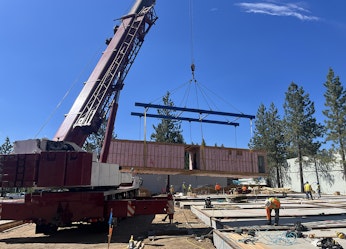

M|O Perspectives
Check back here for our thoughts on the latest developments in our industry.
Navigating the Matrix of Modular Building
Aug 06, 2021
Modular building is a trend that has ebbed and flowed with new ideas and technology since the 19th century. Recently there has been renewed interest in prefabrication for its modern aesthetic, perceived cost and time savings, and ease of construction.
“While some architects have avoided it because of the perception that it would limit what they could do design-wise, others are embracing modular because it’s a trend some clients want to explore,” says Gerard Lee, Vice President in Marx|Okubo’s San Francisco office. Many clients see it as a way to more quickly and cost effectively help address the affordable housing shortage in the country.
Modular design lends itself to certain types of buildings over others. We have worked with modular construction clients in schools, multifamily properties, hotels and commercial buildings, as well as some highly efficient residential modular projects.
Over the years, Marx|Okubo has emerged as an expert voice in modular building. Given our experience in both conventional and modular construction, clients often ask us to provide opinions and advice regarding potential risks and rewards of these different approaches to construction. These clients value our understanding of all angles and balanced perspective when it comes to decision-making around modular design. Some clients proceed fully informed of the challenges of modular applications; others pivot back to a more traditional format to avoid risks.
Modular building design is a sound concept in theory
The concept of modular construction is sound in theory: moving as much construction as possible into a controlled factory environment to increase efficiency and quality while reducing the variability inherent in site-built construction. Minimizing the site-built impact of weather helps to streamline work schedules, better manage labor and trades, and avoid delays.
“Modular manufacturers will sell the picture of a project costing 25% less and being finished faster than conventional construction,” says Tommy Fong, Marx|Okubo Assistant Vice President in Marx|Okubo’s San Francisco office. “These are very tangible benefits to our clients. Not only does the construction cost less in theory by reducing the schedule, construction carry/interest costs are also reduced, and the client will be able to start marketing and leasing the project more quickly and recoup their investment faster.”
Some specialized modular construction manufacturers “package” full-service prefabricated design and installation, but generally this type of construction can run the gamut—from just panelized wall and floor assemblies, to complete finished rooms, units, structures, and even buildings. K-12 public schools for example have relied on modular construction for decades, mainly for budget reasons. Most people have seen this type of modular construction in the form of “portable” buildings that are meant for classroom overflow, but often become “permanent” structures. Several outfits like Project Frog and American Modular have even developed proprietary systems specifically to service schools.
“These outfits were successful when they provided all the modular parts, including the exterior finishes (roofs, windows, doors, cladding, etc.) and only had to coordinate with an onsite contractor for the sitework, foundations, utility connections and setting in place the full finished prefabricated systems,” Lee explains.
We also see this play out in our residential consulting projects, including an inexpensive, highly efficient wood-frame modular product made in Idaho that can be constructed with a limited crew. “With a detailed specification and inspection of modular units during manufacturing and prior to shipping we were able to circumvent some typical onsite issues,” says Executive Chairman Jim Marx.
Cons can outweigh the pros in modular construction
The downfall of modular construction is putting theory into practice. “The real world is not as predictable or easy to control as production on a factory floor,” says Lee. Construction site weather, logistics and labor can all impact the project. As a comparison, building cars in a factory results in a self-contained vehicle that is complete and operational the moment it rolls off the factory floor assembly line. The car does not require additional assembly when it is shipped to the owner or dealership.
In the case of modular projects, semi- or mostly-finished modules can be fabricated similarly within the factory environment; however, unlike a car, they still need to be shipped to the site and erected in concert with other site-built components of the project. You still need to use heavy equipment to grade the site, install underground utilities and connections, foundations/slab-on-grade or podium—all constructed on schedule prior to being ready to receive the modular components.
Then the modules must be craned into position, set into place, anchored to the site-built structure and stitched together to form a single structure. This is a complicated process in and of itself with many logistical hurdles like how to get the modules from the factory to the site, where to stage them and what to do if some aspect of the site and modular construction do not align as intended after the modules arrive on-site. All of this is before you throw in the traditional vagaries of weather, labor and logistics for materials and other work to be done in the field, not to mention, the effects of the pandemic over the past year and a half.
“We recently worked on such a project where the modules were completed and erected in a timely manner; however, due to coordination issues with the design and construction of the field-built aspects of the project, the time and money savings from the modular approach were completely lost,” says Fong.
Many components of the project need to be field fabricated and installed such as the exterior cladding (at least portions of it where the modules connect), roofing system, elevators and trash chutes, unique, one-off aspects of the building, and exterior amenities and landscape improvements. After the modules are set in place, all of these site built elements can/should in theory all be installed at the same time to achieve maximum efficiency, however having that many trades on-site on the critical path at the same time can be a logistical nightmare and there can be bottle necks in this process if it is not carefully planned out in advance.
A lack of coordination between the modular construction and field construction or delays in the completion of the site-built construction can quickly reduce or eliminate any time or cost savings realized by the modular process.
Architect Rui DeSousa, Associate in Marx|Okubo’s New York office, explains that part of the issue is a disconnect between the designers-of-record and the modular manufacturing designers in the broader understanding and integration of the components. “This leaves the responsibility of overarching interpretation and assimilation in the hands of the construction team,” he says. “Between the speed of construction and lack of oversight from the design team, it has been my experience that errors are likely to result under these circumstances. These errors undercut — and sometimes cancel out — the aforementioned key benefits of modular construction.”
Drawbacks of bidding, regionalization, contracts and labor
Another con to modular construction is the limited number of qualified modular fabricators available to competitively bid and work on projects in a given region. Due to the high capital outlay and learning curve required to successfully start a new modular operation, there are a limited number of fabricators which are typically available to serve a given region.
“Many modular manufacturers have seen the potential and tried to disrupt the industry, but to date most have failed,” Fong says. “These companies inevitability run up against obstacles like inadequate knowledge of construction processes, trying to tackle too many aspects of modular all at once, trying to reinvent the wheel and disrupt established construction supply chains, and having and maintaining the necessary resources, scale and project pipeline to support their operations and achieve the intended efficiencies.”
Trying to utilize fabricators outside of a local region is also problematic, as managing and monitoring fabrication of modules remotely is tricky. The logistics and timing to deliver large, completed modules long distances is challenging, and fabricators from other regions may not be familiar with local/regional differences in code and construction requirements or setup to accommodate such differences. For example, projects in seismic- or hurricane-prone areas are constructed very differently to address those specific concerns. The limited number of fabricators reduces the ability to competitively bid the scope of work and increases risk in the event the selected fabricator cannot perform. Short of a redesign using non-modular techniques, there are few alternatives to turn to after a design has been permitted and approved.
One recent example of this occurred while Marx|Okubo was serving as an owner’s representative for an affordable-housing client considering modular for a multi-family residential project. Based on preliminary pricing from the general contractor during the design development stage, the modular construction would have been approximately 2-3% cheaper than conventional construction and reduced the construction schedule by one to two months. These savings were much less than the idealized values brought up in industry conversations about modular. The contractor identified three potential modular fabricators in the region who could support the project; however, one was located in a different state and another was located in British Columbia. The remoteness of two of the fabricators, including lender financing restrictions for the fabricator located in Canada, led to a focus on the use of the one local fabricator.
“Ultimately, as the design progressed, ownership made the decision to switch back to conventional stick-framed construction due to concerns that the local modular fabricator may not be able to deliver on schedule versus the limited potential savings which might have been achieved otherwise” Fong says.
Another concern is contracts—or the lack of good contracts—that take into account the realities of modular construction. “Responsibilities are difficult to separate when the installation commences,” Lee explains. “On some projects, there’s no contractual relationship between the modular fabricator and the site contractor, and the owner or their construction manager has to bridge that gap. When there is an issue on site, it becomes difficult to determine who is at fault.”
While on other projects, the modular fabricator could be subcontracted under the general contractor, the issue of where liability or risks lies is still inherent in these types of projects. For example, a fabricator may provide a “finished” unit with windows and systems roughed-in, but leave the cladding and utility connections to be installed by the site’s general contractor. But if a window leaks, where is the accountability? Was the defect due to the factory install or something that happened in the field?
There are also questions about labor for modular construction. Most panelized/modular framing lumber is precut and set in jigs for factory personnel to fasten together. In some factories the workers have no real carpentry training or skills, and the quality is apparent when the deliverable is unfinished prefabricated wall and flooring panels. “Most general contractors will tell you that while that prefabrication process saves a lot of time, corrective work on ‘finished’ panels still needs to be performed in the field,” Lee says.
Some fabricators are trying to resolve the quality issues by bringing specific union trades onto the factory floor. This effort not only helps address the issue of quality but the concerns of local unions, which see modular construction as a threat to local labor. This trend of utilizing union labor will be interesting to observe over the next few years and whether its adoption is more widespread across fabricators. Part of this is in response to many local jurisdictions declining to approve modular construction on publicly funded projects because of the perception that local union labor will not be utilized. Similar opposition is raised by unions on privately funded developments in cities with a strong construction union presence.
Weighing the risks and rewards of modular applications
These are some of the questions and scenarios Marx|Okubo walks through with clients considering modular design and construction. During the pre-construction process, our architects and engineers ask critical questions of the design team, developer and modular fabricator to make sure things go as smoothly as possible.
During construction, we watch the process and coordinate with the design and construction teams to make sure the work is proceeding in a planned manner so that when modular components arrive, they go in efficiently and we can help them navigate common obstacles along the way, as well as ensure that the site-built aspects of the project have been adequately coordinated to result in a successful project completed on time and on budget.
As a third-party consultant in architecture, engineering and construction, we provide owners with knowledge to help them decide whether or not to go modular—and help them navigate the varied terrain if they decide to go in that direction.
If you have any questions please reach out to Tommy Fong at tommy_fong@marxokubo.com

What we do.
- Owner's Representation
- Property Condition Assessment
- Project Management
- Constructability Reviews
- Repair | Reconstruction
- Facility Condition Assessment
- Construction Loan Monitoring
- Accessibility
- Building Enclosure
- Fire | Life Safety
- Mechanical | Electrical | Plumbing
- ESG | Sustainability & Resiliency
- Structural Engineering
- ASAP® - Automated Structure Alert Program
Marx|Okubo is a national architecture/engineering/construction consulting firm that works with real estate owners, investors and lenders—at every point of the property lifecycle—to evaluate their building projects, solve complex challenges and implement tailored solutions. We help clients understand their projects’ complexities, so they can make more informed decisions and, ultimately, mitigate their risk.




